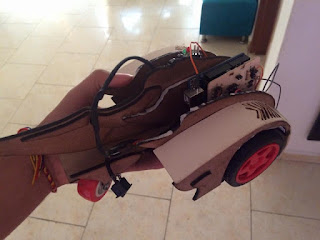Realizamos un carro seguidor de linea el cual todo sus componentes electrónicos son controlados por la tarjeta arduino(UNO), este carro consta de dos sensores CNY70, dos motor reductores los cuales son controlados por el circuito integrado L293D y tambien le agregamos dos LEDs tricolor(estética).
Materiales:
- Arduino UNO con su respectivo cable USB
- Computador con el respectivo software de arduino
- 2 motores reductores
- 2 sensores CNY70
- Diodos 1n4007 de proteccion
- Resistencias 330 y 1k
- Integrado L293D
- Chasis de material MDF
- Carton paja
- Rueda loca
- Cables
Diagrama:
Montaje
PCB
(Vaquela)
Código
- // Proyecto Final
- // Programa Arduino
- // Seguidor de linea
- // Johnson Camilo Barona Sanchez
- // Programacion de sistemas embebidos
- // Universidad Santiago de Cali
- // inicio de código
- // Declaramos las constantes
- const int pinSensorA = 0;
- const int pinSensorB = 1;
- const int pinMotorA = 5;
- const int pinMotorB = 6;
- const int pinMotorC = 9;
- const int pinMotorD = 10 ;
- // Declaramos las variables
- int ValorSensorA;
- int ValorSensorB;
- // Declaracion de constantes como salidas
- void setup() {
- pinMode(pinMotorA,OUTPUT);
- pinMode(pinMotorB,OUTPUT);
- pinMode(pinMotorC,OUTPUT);
- pinMode(pinMotorD,OUTPUT);
- // Inicia los motores apagados
- digitalWrite(pinMotorA, LOW);
- digitalWrite(pinMotorB, LOW);
- digitalWrite(pinMotorC, LOW);
- digitalWrite(pinMotorD, LOW);
- }
- void loop() {
- //Asigna lectura analoga de los sensores a las variables valor sensor A y sensor B B
- ValorSensorA = analogRead(pinSensorA);
- ValorSensorB = analogRead(pinSensorB);
- // condicion para el sensor A
- if(ValorSensorA <= 10)
- {
- digitalWrite(pinMotorA, LOW);
- digitalWrite(pinMotorB, HIGH);
- }
- else {
- digitalWrite(pinMotorA, HIGH);
- digitalWrite(pinMotorB, LOW);
- }
- // condicion para el sensor B
- if(ValorSensorB <= 110)
- {
- digitalWrite(pinMotorC, LOW);
- digitalWrite(pinMotorD, HIGH);
- }
- else {
- digitalWrite(pinMotorC, HIGH);
- digitalWrite(pinMotorD, LOW);
- }
- }
Proceso de Montaje
Integrado
Motores reductores
Senosr CNY70
Vídeo corte de algunas piezas
Después de cortado nuestro chasis procedemos a ensamblar las piezas y componentes electrónicos.
Vídeo Funcionamiento















